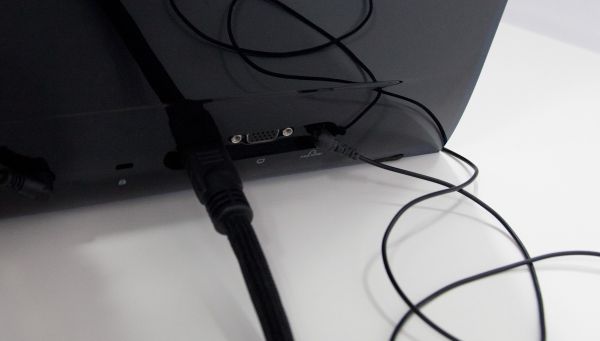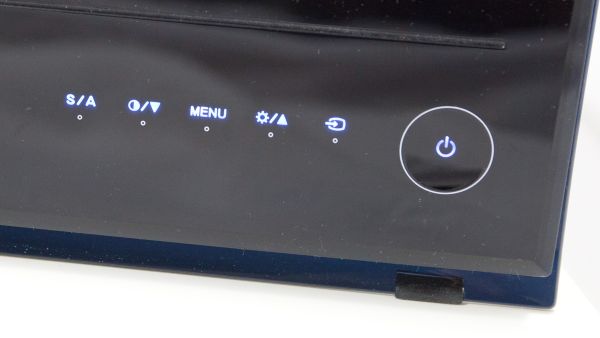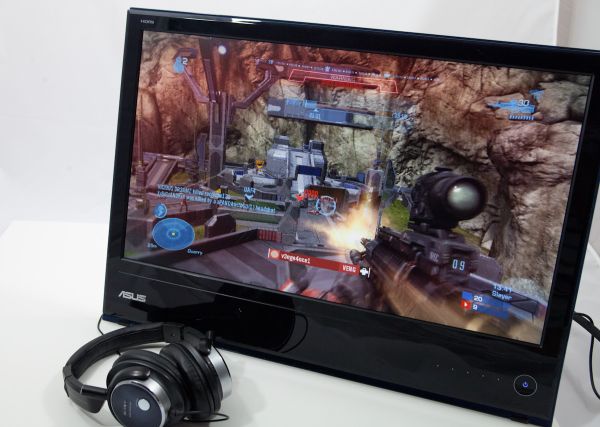ASUS MS238H Review - Slim and Affordable
by Brian Klug on December 24, 2010 1:47 AM ESTOSD and Gaming
One of the nice things about the MS238H is that the display includes a much-needed 3.5mm headphone jack for HDMI audio pass through. It's amazing how many displays include HDMI, yet provide no audio out options for when you want to connect a game console and just use HDMI. On displays without the jack, the only alternative is using old-school RCA plugs and a 3.5mm headphone jack converter, and (because I've yet to find one that has a female plug) probably a female-female headphone jack so you can actually use the connection. More and more displays are starting to carry an option for stereo out like the MS238H does, however, which is awesome.
Even better, the OSD controls include volume controls, which is incredibly welcome even if it takes at least 5 OSD selections to actually reach the volume control window. The only problem with the headphone jack on the MS238H is its location - it's on the rear which is a bit of an inconvenience if you're constantly swapping headsets or don't have a long cable. On the other hand, since there's only one HDMI jack, if you're switching from your desktop to a console constantly, you're going to have to go back there anyways.
I normally leave our OSD walkthrough until the end, but I think it's worth mentioning that the OSD controls include the right set of scaling options: full, 4:3, and overscan. There's no 1:1 explicitly provided, but if you're using HDMI chances are good you're connecting to something which drives the panel's native resolution of 1920x1080 so it's a moot point. The OSD style and majority of settings are essentially the same as I saw on the VG236H.
I can't complain about the OSD on the MS238H - it's standard ASUS fare with the appropriate changes for this particular panel. There are presets which include standard and game modes, overdrive controls under "Trace Free" (which basically gets turned on when you select game mode), dynamic contrast under "ASCR", RGB gain controls, aspect ratio, volume, and more. All in all nothing surprising or out of the ordinary.
I did find that sometimes the capacitive OSD buttons can mis-sense a press and keep sending input for a few seconds after your finger is lifted off the button. While adjusting brightness and contrast for calibration, I unintentionally sent the display to maximum and minimum a few times more than I would've liked to. After a few presses it's easy to get the hang of, but I still vastly prefer mechanical buttons. It gets frustrating fast when you're trying to nail a specific brightness or color temperature for calibration and have to tediously enter and exit menus, all while being super careful about how delicately you're touching buttons. The average end user might only dive into menus once a month or less, but it's still an occasional hit or miss experience.
Some of the button markings are confusing. The one marked S/A is a bit odd - most of the time it functions as exit or back, while menu is select and enter. I guess I find those confusing since S seems to imply Select, even though I know ASUS means "Splendid" preset settings. Tapping on the contrast symbol quickly brings up the change contrast window, and tapping the brightness button brings up brightness - the two buttons then change to down and up respectively.
I played a lot of Halo Reach on the MS238H and found the combination of headphone jack and HDMI perfectly suited for the task. My Sony MDR-NC50 headsets usually require a ton of drive power to even sound what I'd consider adequate, but sounded loud enough on the display's headset jack. I'll get to it in a moment but I couldn't detect any lag on the MS238H - if anything, the time I played on the MS238H led me to discover that my newly constructed combination of TV and A/V receiver is incredibly laggy by comparison.




















38 Comments
View All Comments
CharonPDX - Friday, December 24, 2010 - link
Is this what you are looking for?http://www.amazon.com/Male-3-5mm-Stereo-Female-Y-C...
Brian Klug - Saturday, December 25, 2010 - link
Wow, this is actually exactly what I've always wanted. I've got a million RCA->female 3.5mm stereo jacks with female-female connectors on them for when I use my consoles with my FP241W displays. This is awesome! Our commenters rock! Thanks!-Brian
jmunjr - Friday, December 24, 2010 - link
16:9 is absolutely absurd for a computer monitor... I don't know where this trend came from but my guess is the LCD makers realized they could make more profits this way and did some nifty marketing to dupe the morons in the world into thinking it was actually a better format for computing...In protest I have modified a dozen or so of my popular websites by reducing their widths to require even more vertical space.
bhopfner - Friday, December 24, 2010 - link
It's totally true! A widescreen monitor is 20% smaller than the same monitor at 4:3. So of course the LCD industry went with that format. They must save millions. Sure a movie looks great and some games take advantage of the format but for general computing it doesn't help. I want my 20% extra screen real estate!sprockkets - Friday, December 24, 2010 - link
This is dumb. My web browser fits just fine here, and compared to my old 1280x1024 monitor resolution on a 17" monitor, it isn't losing any pixels.This is just another stupid made up issue.
How about I can't use my cable box with a 1920x1200 box without some distortion happening without correction? Ever thought about why they went to 1920x1080? Really missed those 80 pixels on a 1280x800 vs. 1280x720 either?
dertechie - Friday, December 24, 2010 - link
If a 23" monitor barely gains vertically on a 17" monitor, that's not a good thing.You can't use your cable box with a 1920x1200. That's an indictment of the cable box or a monitor designer that neglected to include a 1:1 or preserve aspect ratio mode, not an indictment of the aspect ratio.
We have thought about why they went to 16:9. They can get 11% more panels from a sheet of mother glass (and that's not even counting being able to find more efficient ways to cut it, it may be more). HDTV popularized it, they sell better, and economy of scale compounds that. I actually like seeing 1080p on screens below 24", it's a step forward there.
For media, 1080p is great. Where I don't like 1080p is when I see it in the areas I used to see 1920x1200. 24"-28" monitors used to be mainly 1920x1200. Now, they're mainly 1080p and you have to actually look to find a 16:10 one. It feels like we've regressed instead of going forward. For those of us doing vertically oriented work (like programming), those 120 pixels actually do matter. Nice monitors let you turn the screen, but cheap monitors (and especially cheap TN monitors) don't allow that.
Fritzr - Monday, December 27, 2010 - link
Your cable box should work just fine with a 1920x1200 display. You should see a black band above and below the TV picture though. What you cannot do on a 1920x1080 display is use 1920x1200 wallpaper (a standard size) without distorting it with the 'stretch to fit' display setting.Those blsck bands are NOT a failure of your cable box. It is called letterboxing. The black bands represent the unused portion of the display. If you watch SD broadcasts without reformatting, you will see the same banding on the sides as the picture is not wide enough to fill the screen.
Many HD TVs have an automatic adjustment that stretches the picture to fit the screen. This results in distorted video when viewing 16:9 content on a 4:3 screen and vice versa.
Personally I will accept the penalty imposed by a 16:10 aspect ratio where I am forced to see more of the web page than an HDTV can display.
I would like to get one of the higher resolution screens also. You should avoid those like the plague though...A 3840x2400 cinema class monitor would display your TV screen as a tiny box in the center of the display ... at least until you enable 'stretch to fit display' anywho.
Really scary though is the next generation UltraHiDef TV standard that has been demonstrated in Japan 7680x4320 (16:9) and tbe WHUXGA monitor standard at 7680x4800 (16:10) Those would be nice for big screen displays :)
MobiusStrip - Saturday, January 1, 2011 - link
You won't see this in the U.S. Our asinine "advanced" TV "standard" still allows interlacing and a non-integer frame rate, caps the bitrate at 19 megabits per second, and did not require sets to have updatable firmware. Nor does it define what "HD" means. How many ways can you fail?Then again, we're talking about the successor to the governing body that came up with 29.97 FPS in the first place.
mike8675309 - Thursday, December 30, 2010 - link
People just don't get it, and it is a flaw due to the shift in technology from analog monitors to digital monitors. Their expectations are just so much lower because the common use case simply doesn't demand the vertical resolution.Back in the day where dot pitch and image masks everyone understood what was better, and what was worse. These days they see 24" vs 17" and assume it's better, when in fact it can often be worse and at best, only minimally better.
Sure, movies work at these low vertical resolutions. So do web pages, for the most part. But for software developers and many other technology professionals these low vertical resolutions completely bite and are a tremendous step backward from the reasonably priced performance levels achievable with CRT's in the early 90's.
Sepidoel - Friday, December 24, 2010 - link
Very unfortunate, in my country it's sold way pricier than Amazon (about 340 USD). In regards of 23" LCD, perhaps you may compare it with AOC iF23 - an IPS LED LCD with very affordable price (about 270 USD in my place). I bought one for my sister and I say this is great monitor for the price. I'd like to write an article for Anandtech, but I just simply don't know how to bring up the benchmark numbers.Amazon URL for the 22" one: http://www.amazon.com/22IN-LCD-1920X1080-30000-Pia...